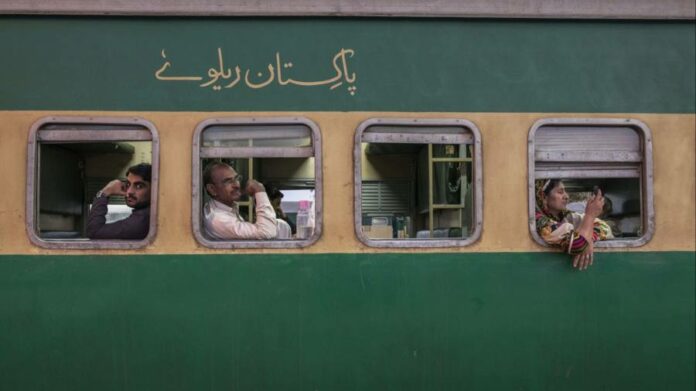Since the 19th century, Pakistan’s clattering railways have carried passengers and cargo from the Arabian Sea to the Himalayas. But the colonial-era network is in severe disrepair, with decrepit trains and some tracks left unusable by devastating flooding last year.
Together with its close ally China, Pakistan is now preparing at least a partial solution: a $10bn revamp of its 1,700km arterial Main Line 1 railway to be paid for with loans from Beijing.
Prime Minister Shehbaz Sharif and President Xi Jinping agreed in November to begin work on the line, which links the southern port city of Karachi to Lahore and the capital, Islamabad. The project is expected to increase maximum train speeds on the route to 160kph.
But the ML1 upgrade has raised questions about whether heavily indebted Pakistan should be borrowing billions of dollars more for expensive infrastructure at a time of severe financial strain.
Some analysts believe Pakistan, which owes about $100bn in external debt to lenders including the World Bank and China, is at risk of defaulting after a plunge in its foreign exchange reserves.
Ahsan Iqbal, Pakistan’s planning minister, said the ML1 upgrade was vital to keep trains running and an example of the transformative work that Chinese credit had made possible.
“If we do not undertake this project, in a couple of years Pakistan will lose its railway logistics,” Iqbal told the Financial Times.
“The whole railway system will break down, this main line will break down. It will be very risky to run commercial operations on this track. It is no longer a choice. It is an imperative.”
But critics said taking on more debt for the ML1 project was an example of the kind of bad borrowing decisions that had led Pakistan into successive economic crises in recent years. Pakistan’s foreign reserves have sunk to below $6bn, or equivalent to less than one month of imports.
The government “is fooling the country”, said Zubair Khan, a former Pakistani commerce minister and IMF official, who argued Pakistan was closer to running out of reserves than officials acknowledged. “There are truths being hidden.”
Iqbal, who oversees Pakistan’s involvement in the Belt and Road Initiative, China’s international infrastructure scheme, said it would take six to nine years to complete the ML1 upgrade. The work will include replacing track, modernising signalling, converting level crossings into underpasses or flyovers and building fences to stop cattle crossing the line.
The planning minister said the project would proceed in phases “to make it more manageable”, with an initial cost of $3bn. The loan from China would be repayable over 20 to 25 years and would be “concessional”, he said, without providing further details.

Chinese lending to Pakistan goes back years, part of an effort to forge economic and military ties that will help to counter their mutual rival India. The ML1 upgrade is part of the China-Pakistan Economic Corridor, a BRI centrepiece with an estimated total cost of $60bn.
The CPEC also includes Chinese development of a deep-sea port at Gwadar in south-western Pakistan, among other projects. Beijing is separately supplying Pakistan’s military with eight submarines and advanced J-10 C fighter jets.
A western diplomat in Islamabad said that for such projects to have continued even as Beijing saw growing financial distress in BRI recipient countries pointed to the importance it put on ties with Pakistan.
“Even if the rest [of BRI] lags behind, China wants to stay the course with Pakistan,” the diplomat said, adding that the relationship had “important military aspects developed over the long term”.
The projects — and Chinese financing — have also stoked domestic tensions. Police in Gwadar last month imposed emergency measures and dismantled a protest camp that had obstructed operations at the port with demands, among others, for Chinese nationals to leave.

Projects such as ML1 have also fuelled analyst concerns over whether excessive Chinese lending is exacerbating strains on Pakistan’s precarious finances. Chinese state lenders are together among the largest creditors to Islamabad, accounting for about $30bn of its outstanding debt.
Abid Hasan, an economist and former World Bank adviser, argued ML1 should be “deferred”, saying Pakistan ought to suspend public investment that generated revenue in rupees but was financed with foreign currency debt.
Sakib Sherani of advisory firm Macro Economic Insights said it was unfair to single out China’s role in Pakistan’s debt woes, with the largest repayments in the current financial year actually due to multilateral lenders.
But Chinese loans tend to carry higher interest rates than multilateral or other bilateral creditors, according to the AidData research lab at William & Mary college in the US. Chinese annual interest is typically 3-4 per cent compared with 1-2 per cent from OECD lenders, AidData said.
Even as it taps Beijing for the ML1 project, Pakistan is looking elsewhere for funds to help stabilise its shrinking reserves. The finance ministry is in talks with the IMF to secure the next tranche of a $7bn assistance programme, and has said it will approach “friendly” countries such as Saudi Arabia for more loans.
Sharif’s government is betting it can steady the economy in time for parliamentary elections that must be held before the end of this year.
Iqbal said he was confident the country would pull through. “Pakistan is facing economic [and] fiscal difficulties, but it is not in the range that it is a default economy yet. We are managing very prudently.”






